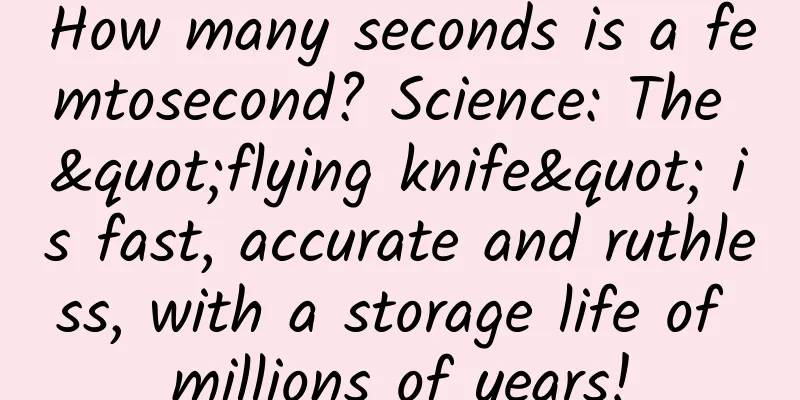How many seconds is a femtosecond? Science: The "flying knife" is fast, accurate and ruthless, with a storage life of millions of years!

|
Laser is called "the fastest knife", "the most accurate ruler" and "the brightest light". Since the invention of the first laser in the early 1960s, it has been widely used in all aspects of our lives. In the 1980s, scientists invented a peculiar laser, the femtosecond laser, which is a pulsed laser that emits within a femtosecond period of time, which means that energy is released instantly within a femtosecond. It has the characteristics of ultrafast, ultrastrong and ultrawide spectrum, and now many ophthalmic myopia correction surgeries use femtosecond lasers. However, the mechanism of interaction between femtosecond lasers and matter is intricate and there are still many questions. Even researchers cannot figure out its "temper". On January 21, Science published the latest results of the team led by Professor Qiu Jianrong from the School of Optoelectronic Science and Engineering at Zhejiang University. The research team discovered the spatially selective micro-nanophase separation and ion exchange laws induced by femtosecond lasers, pioneered a new femtosecond laser three-dimensional extreme manufacturing technology, and for the first time realized a three-dimensional semiconductor nanocrystal structure with controllable band gap inside a colorless and transparent glass material. This will provide a new direction for the next generation of display and storage technologies. Image source: CCTV News Client What's so amazing about femtosecond laser? Femtosecond is a unit of measurement for the length of time, also known as femtosecond. One femtosecond is one quadrillionth of a second. Femtosecond laser, as the name implies, is a pulsed laser emitted within a femtosecond period of time, which means that energy is released within femtoseconds. The amazing thing about femtosecond lasers is that, first, the instantaneous peak power is very high, even a hundred times more than the total power generated in the world; Second, it can be focused into a space smaller than the diameter of a hair, making the electromagnetic field stronger than the force exerted by the nucleus on the electrons around it. When a femtosecond laser is focused into a transparent material, a series of physical and chemical kinetic processes based on a variety of highly nonlinear effects will occur. Because of its ultra-fast and ultra-strong characteristics, femtosecond lasers are widely used in various fields such as information, environment, energy, and medicine. "Why can femtosecond lasers be used for eye surgery? Because the eye is rich in nerves and blood vessels, surgery requires stability, accuracy, and ruthlessness, and this 'laser knife' is clean and sharp, and only works on the focal point area without affecting the surrounding environment," said Qiu Jianrong. Is the steady, accurate and powerful femtosecond laser similar to the flying dagger of Li Xiao in Gu Long's novels that never miss its target? Uncover the secret of "Flying Knife" When a femtosecond laser is focused into a transparent material, a series of physical and chemical kinetic processes based on a variety of highly nonlinear effects occur. Despite the many uses of femtosecond lasers, researchers still know very little about their mechanisms. The first step to achieve this result was to prepare uniform and transparent glass. "If there are bubbles, stones or stripes in the glass, it will affect the refractive index distribution, and ultimately lead to a drastic change in the interaction between light and glass based on the multiphoton effect." The research team used the rich experience accumulated from long-term research and successfully fired a uniform precursor glass suitable for laser processing based on a large number of experiments. The next step is to focus the femtosecond laser onto the inside of the glass. However, the team did not find a pattern in the initial experiments, so Qiu Jianrong's team carried out the "carpet bombing" test mode they have always advocated, making repeated adjustments and repeated experiments. After careful design and a series of optimizations, the team finally obtained the ideal ultrafast laser engraving process and successfully realized the composition-adjustable perovskite nanocrystals inside the glass (Figure 1), which can realize the structure and performance control at will in the "instant" time scale. Photoluminescence spectrum of CsPb(Br1-xIx)3 perovskite nanocrystals with adjustable composition in ultrafast laser direct writing glass, and the corresponding optical and fluorescence images, scale bar is 10μm Image source: Zhejiang University WeChat official account The next step was how to make the laser carve a three-dimensional pattern composed of many pixels in an instant? How to use a transmission scanning electron microscope to observe the incisions that are much thinner than a hair? The team overcame difficulties one by one in their down-to-earth research.
Optical storage may become a new generation of storage and display materials "I have always believed that there are no shortcuts in scientific research. We need to carry out our work honestly and step by step," said Qiu Jianrong. This research was based on a large number of experiments and achieved perovskite nanocrystals with adjustable composition inside the glass, which can control the structure and performance at will on a "flash" time scale. Colorful luminescent patterns and holographic displays of perovskite nanocrystals in glass by femtosecond laser three-dimensional direct writing. Image source: Zhejiang University WeChat official account To further demonstrate the characteristics of this technology, the researchers achieved color patterning of perovskite nanocrystals for multidimensional information encoding and anti-counterfeiting within micron-level precision, as well as full-color luminescent patterns and 3D micro-spiral direct writing and three-dimensional holographic display inside a piece of Cl-Br-I co-doped glass. Since ultrafast laser-induced liquid-phase nanoseparation only occurs at local locations inside the glass, 3D laser direct writing technology eliminates contamination from organic components (reagents and solvents) during material synthesis and device processing. In addition, stability experiments show that such devices can be used for a long time in various environments. One application direction of this research is optical storage in three, four or even more dimensions. "Most existing storage devices are magnetic storage, which has some disadvantages. First, the service life is only 3 to 5 years. Second, the energy consumption is relatively high and the heat dissipation requirements are high." Dr. Tan Dezhi from Zhijiang Laboratory, one of the corresponding authors of the paper, said that optical storage not only consumes little power, but also has a capacity expected to reach 1PB/disc, which will be a promising development direction, and the expected storage lifespan will reach millions of years. Related paper information: https://doi.org/10.1126/science.abj2691 Comprehensive sources: CCTV News Client, China Science Daily, Zhejiang University WeChat Official Account, etc. |
>>: Does raising a hairless cat mean you don’t have allergies? No!
Recommend
Approaching attoseconds! Electron microscope breaks through the limit of time and space resolution
The hot topic related to attoseconds is that this...
Be careful of rotting your feet when wading after rain! Here’s what you should do →
In addition to the direct damage of collapsing bu...
The 4 golden rules of sales copywriting! (two)
If a title cannot attract people to click on it w...
April 2022 "Science" Rumors List: Drinking Coke will cause a positive antigen test? Dogs also shed tears when they are wronged?
The monthly "science" rumor list is gui...
9 ways to attract traffic for offline promotion!
How can offline brand store merchants build a tra...
Take it before or after meals? Here is a list of common medication times! Don’t be careless, save it now!
We often see instructions such as "take befo...
European Automobile Manufacturers Association: European new car sales in November 2024 will be 1.06 million, a year-on-year decrease of 2%.
European car sales fell last month as slowing dem...
Official account: The Course on the Monetary Emotion Cycle of Speculative Capital
Course Description This course focuses on explain...
How to achieve product growth through “circle fission”?
People in society are divided into different leve...
Technical topics·Machine learning
[[162319]] Wu Lei, head of Umeng data platform: T...
Is the "silver needle test for poison" in TV dramas real? Just for entertainment, don't take it seriously!
In ancient times, there was a common method of te...
How to use “message push” so as not to harass users? ——Taking financial apps as an example
Imagine this scenario: On a clear autumn afternoo...
Quantum bowling: a fascinating collision of the microscopic world
Science friends in China, come explore the magica...
Brand marketing innovation theory!
How to create such a Tribe "new community&qu...
Internet promotion must start with understanding users!
2016 was also a year of rapid development of the I...









